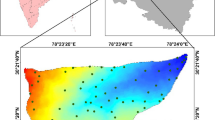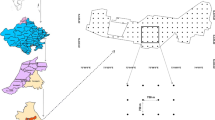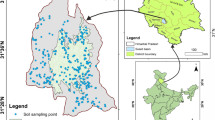Abstract
Coastal agriculture occupies significant farmlands providing livelihood to the rural community. Delineation of soil management zones in the coastal region is essential to get more economic return through reducing environmental risk, crop inputs. The present study aims to delineate the soil management zones in part of the coastal agriculture system in Ganjam block, Odisha part of Eastern India. Assessment of spatial variability of soil nutrients and satellite-derived vegetation indices, i.e., normalized difference vegetation index (NDVI), enhanced vegetation index (EVI), and soil-adjusted vegetation index (SAVI) were used for better crop management decisions. A total of 85 geo-referenced representative surface soil samples at 0–25 cm depth were collected randomly from different landuse and landforms. Soil samples were analyzed for pH, EC, organic carbon (OC), available nitrogen (AN), available phosphorus (AP), available potassium (AK), and micronutrients (Fe, Mn, Cu, and Zn), and spatial distribution maps were developed using geostatistical techniques. The soil electrical conductivity (EC), iron (Fe), and available potassium (AK) show a high coefficient of variation (CV) of 139.95%, 84.37%, and 78.34%, respectively. The site-specific soil management zones were delineated by principal component analysis (PCA) and fuzzy c means clustering algorithm. Four principal components were selected in the present study, representing a total variance of 69.29% with eigenvalues > 1 using the soil and vegetation attributes. Fuzzy c means clustering was performed for the scores of the selected principal components (PCs) along with the Fuzzy Performance Index (FPI) and Modified Partition Entropy (MPE) was used for determining the optimum number of management zones. Five soil management zones were delineated in the study area and the significant difference between the management zones was identified by analysis of variance. The delineated MZs significantly differ concerning soil and vegetation parameters, thus knowledge of soil variability and site-specific management zones helps for sustainable utilization of resources and reducing soil degradation, and maximizing crop yield.






Similar content being viewed by others
References
Abdul, R. A., Kah, J. G., Tee, B. H., & Osumanu, H. A. (2007). Transforming spatio-temporal yield maps to classified management zone maps for efficient management of oil palm. American Journal of Applied Sciences, 5, 1392–1396.
Aggelopooulou, K., Castrignanò, A., Gemtos, T., & De Benedetto, D. (2013). Delineation of management zones in an apple orchard in Greece using a multivariate approach. Computers and Electronics in Agriculture, 90, 119–130. https://doi.org/10.1016/j.compag.2012.09.009
Barman, A., Sheoran, P., Yadav, R. K., Abhishek, R., Sharma, R., Prajapat, K., Singh, R. K., & Kumar, S. (2021). Soil spatial variability characterization: Delineating index-based management zones in salt-affected agroecosystem of India. Journal of Environmental Management, 296, 113243. https://doi.org/10.1016/j.jenvman.2021.113243
Behera, S. K., Ravi, K., Mathur, R. K., Shukla, A. K., Suresh, K., & Prakash, C. (2018). Spatial variability of soil properties and delineation of soil management zones of oil palm plantations grown in a hot and humid tropical region of southern India. CATENA. https://doi.org/10.1016/j.catena.2018.02.008
Black, C. A. (1965). Methods of soil analysis. Part 2, chemical and microbiological properties. American Society of Agronomy.
Brevik, E. C., Cerdà, A., Mataix-Solera, J., Pereg, L., Quinton, J. N., Six, J., & Van Oost, K. (2015). The interdisciplinary nature of soil. The Soil, 1, 117–129.
Cambardella, C. A., Moorman, T. B., Novak, J. M., Parkin, T. B., Karlen, D. L., Turco, R. F., & Konopka, A. E. (1994). Field-scale variability of soil properties in Central Iowa soils. Soil Science Society of America Journal, 58(5), 1501–1511. https://doi.org/10.2136/sssaj1994.03615995005800050033x
Chaudhary, D. R., Ghosh, A., & Boricha, G. N. (2008). Characterization and classification of coastal saline soils of Paradip, Orissa. Agropedology, 18(2), 129–133.
Chen, H., Shen, Z., Liu, G., & Tong, Z. (2009). Spatial heterogeneity of available zinc, copper, and manganese in Xiangcheng tobacco planting fields, Henan Province, China. Frontiers of Biology in China, 4, 469–476.
Das, M., Sethi, R. R., & Sahoo, N. (2010). Evaluation and integration of soil salinity and water data for improved land use of underproductive coastal area in Orissa. Irrigation and Drainage, 59(5), 621–627. https://doi.org/10.1002/ird.519
Davatgar, N., Neishabouri, M. R., & Sepaskhah, A. R. (2012). Delineation of site specific nutrient management zones for a paddy cultivated area based on soil fertility using fuzzy clustering. Geoderma, 173–174, 111–118. https://doi.org/10.1016/j.geoderma.2011.12.005
Dey, P., Santhi, R., Maragatham, S., & Sellamuthu, K. M. (2017). Status of phosphorus and potassium in the Indian soils vis-a-vis world soils. Indian Journal of Fertilisers, 13(4), 44–59.
Dharumarajan, S., Hegde, R., & Singh, S. K. (2017). Spatial prediction of major soil properties using random forest techniques—A case study in semi-arid tropics of South India. Geoderma Regional, 10, 154–162. https://doi.org/10.1016/j.geodrs.2017.07.005
Dinauer, R. (1982). Methods of soil analysis. ASA, SSSA.
Evrendilek, F., Celik, I., & Kilic, S. (2004). Changes in soil organic carbon and other physical soil properties along adjacent Mediterranean forest, grassland, and cropland ecosystems in Turkey. Journal of Arid Environments, 59(4), 743–752. https://doi.org/10.1016/j.jaridenv.2004.03.002
Foroughifar, H., Jafarzadeh, A. A., Torabi, H., Pakpour, A., & Miransari, M. (2013). Using geostatistics and geographic information system techniques to characterize spatial variability of soil properties, including micronutrients. Communications in Soil Science and Plant Analysis, 44(8), 1273–1281. https://doi.org/10.1080/00103624.2012.758279
Fridgen, J. J., Kitchen, N. R., Sudduth, K. A., Drummond, S. T., Wiebold, W. J., & Fraisse, C. W. (2004). Management zone analyst (MZA) software for subfield management zone delineation. Agronomy Journal, 96(1), 100–108.
Gamon, J. A., Field, C. B., Goulden, M. L., Griffin, K. L., Hartley, A. E., Joel, G., Peñuelas, J., & Valentini, R. (1995). Relationships between NDVI, canopy structure, and photosynthesis in three californian vegetation types. Ecological Applications, 5(1), 28–41. https://doi.org/10.2307/1942049
Gomez, C., Viscarra, R. A., & Mcbratney, A. B. (2008). Soil organic carbon prediction by hyperspectral remote sensing and field vis-NIR spectroscopy: An Australian case study. Geoderma, 146, 403–411. https://doi.org/10.1016/j.geoderma.2008.06.011
Goovaerts, P. (1998). Geostatistical tools for characterizing the spatial variability of microbiological and physico-chemical soil properties. Biology and Fertility of Soils, 27(4), 315–334. https://doi.org/10.1007/s003740050439
Hasan, B. R. (1996). Phosphorus status of soils in india. Crops, 10(2), 4–5.
Hejase, A. J., & Hejase, H. J. (2013). Research methods: A practical approach for business students. Masadir Incorporated.
Huang, B., Sun, W., Zhao, Y., Zhu, J., Yang, R., Zou, Z., & Su, J. (2007). Temporal and spatial variability of soil organic matter and total nitrogen in an agricultural ecosystem as affected by farming practices. Geoderma, 139(3–4), 336–345.
Huete, A., Justice, C., & Van Leewen, W. (1999). MODIS vegetation index (MOD13) algorithm theoretical basis document, version 3. University of Arizona.
Huete, A. R., Didan, K., Miura, T., Rodriguez, E. P., Gao, X., & Ferreira, L. G. (2002). Overview of the radiometric and biophysical performance of the MODIS vegetation indices. Remote Sensing of Environment, 83(1–2), 195–213. https://doi.org/10.1016/S0034-4257(02)00096-2
Jiang, H. L., Liu, G. S., Wang, R., Liu, S. D., Han, F. G., Yang, Y. F., & Hu, H. C. (2011). Delineating site-specific quality-based management zones for a tobacco field. Soil Science, 176(4), 206–212. https://doi.org/10.1097/SS.0b013e3182121453
Jolliffe, I. T. T. (2002). Principal component analysis (2nd ed.). Springer.
Kalambukattu, J. G., Kumar, S., & Ghotekar, Y. S. (2018). Spatial variability analysis of soil quality parameters in a watershed of sub-himalayan landscape—A case study. Eurasian Journal of Soil Science, 7(3), 238–250. https://doi.org/10.18393/ejss.427189
Kumar, S., Kumar, A., Saha, S. K., & Kumar, A. (2009). Stereo Cartosat-1 satellite remote sensing data in assessing topographic potential of soil erosion. The Indian Society of Remote Sensing, 36(2), 159–165. https://doi.org/10.1007/s12524-008-0016-0
Ladoni, M., Bahrami, H. A., Alavipanah, S. K., & Norouzi, A. A. (2010). Estimating soil organic carbon from soil reflectance: A review. Precision Agriculture, 11(1), 82–99.
Lal, R., Follett, R. F., Stewart, B. A., & Kimble, J. M. (2007). Soil carbon sequestration to mitigate climate change and advance food security. Soil Science. https://doi.org/10.1097/ss.0b013e31815cc498
Li, D. Q., Jiang, S. H., Cao, Z. J., Zhou, W., Zhou, C. B., & Zhang, L. M. (2015). A multiple response-surface method for slope reliability analysis considering spatial variability of soil properties. Engineering Geology, 187, 60–72. https://doi.org/10.1016/j.enggeo.2014.12.003
Li, Y., Shi, Z., Li, F., & Li, H. Y. (2007). Delineation of site-specific management zones using fuzzy clustering analysis in a coastal saline land. Computers and Electronics in Agriculture, 56(2), 174–186. https://doi.org/10.1016/j.compag.2007.01.013
Lindsay, W. L., & Norvell, W. A. (1978). Development of a DTPA soil test for zinc, iron, manganese, and copper. Soil Science Society of America Journal, 42(3), 421–428. https://doi.org/10.2136/sssaj1978.03615995004200030009x
Lobell, D. B., Asner, G. P., Ortiz-Monasterio, J. I., & Benning, T. L. (2003). Remote sensing of regional crop production in the Yaqui Valley, Mexico: Estimates and uncertainties. Agriculture, Ecosystems & Environment, 94(2), 205–220.
Mallick, J., Ahmed, M., Alqadhi, S. D., Falqi, I. I., Parayangat, M., Singh, C. K., Rahman, A., & Ijyas, T. (2020). Spatial stochastic model for predicting soil organic matter using remote sensing data. Geocarto International. https://doi.org/10.1080/10106049.2020.1720314
Mandal, C., Mandal, D. K., Bhattacharyya, T., Sarkar, D., Pal, D. K., Prasad, J., & Thakre, S. (2014). Revisiting agro-ecological sub-regions of India—A case study of two major food production zones. Current Science, 107(9), 1519–1536. https://doi.org/10.18520/cs/v107/i9/1519-1536
McKenzie, N. J., & Ryan, P. J. (1999). Spatial prediction of soil properties using environmental correlation. Geoderma, 89(1–2), 67–94.
Moharana, P. C., Jena, R. K., Pradhan, U. K., Nogiya, M., Tailor, B. L., Singh, R. S., & Singh, S. K. (2019). Geostatistical and fuzzy clustering approach for delineation of site-specifc management zones and yield-limiting factors in irrigated hot arid environment of India. Precision Agriculture. https://doi.org/10.1007/s11119-019-09671-9
Metwally, M. S., Shaddad, S. M., Liu, M., Yao, R. J., Abdo, A. I., Li, P., & Chen, X. (2019). Soil properties spatial variability and delineation of site-specific management zones based on soil fertility using fuzzy clustering in a hilly field in Jianyang, Sichuan, China. Sustainability. https://doi.org/10.3390/su11247084
Meyer, D., Dimitriadou, E., Hornik, K., Weingessel, A., Leisch, F., Chang, C. C., & Lin, C. (2015). Misc functions of the department of statistics, probability theory group (formerly: E1071). Package E1071. TU Wien.
Nawar, S., Corstanje, R., Halcro, G., Mulla, D., & Mouazen, A. M. (2017). Delineation of soil management zones for variable-rate fertilization: A review. Advances in Agronomy, 143, 175–245.
Naidu, L. G. K., Ramamurthy, V., Sidhu, G. S., & Sarkar, D. (2011). Emerging deficiency of potassium in soils and crops of India. Karnataka Journal of Agricultural Sciences, 24(1), 12–19.
Nielsen, D. R., & Wendroth, O. (2003). Spatial and temporal statistics: Sampling field soils and their vegetation. Reiskirchen: Catena Verlag. Retrieved from https://www.cabdirect.org/cabdirect/abstract/20033041440
Odeh, I. O. A., McBratney, A. B., & Chittleborough, D. J. (1992). Soil pattern recognition with fuzzy-c-means: Application to classification and soil-landform interrelationships. Soil Science Society of America Journal. https://doi.org/10.2136/sssaj1992.03615995005600020050x
Oldoni, H., Silva Terra, V. S., Timm, L. C., Júnior, C. R., & Monteiro, A. B. (2019). Delineation of management zones in a peach orchard using multivariate and geostatistical analyses. Soil and Tillage Research, 191, 1–10. https://doi.org/10.1016/j.still.2019.03.008
Olsen, S. R. (1954). Estimation of available phosphorus in soils by extraction with sodium bicarbonate. US Department of Agriculture.
Peralta, N. R., & Costa, J. L. (2013). Delineation of management zones with soil apparent electrical conductivity to improve nutrient management. Computers and Electronics in Agriculture, 99, 218–226. https://doi.org/10.1016/j.compag.2013.09.014
Peralta, N. R., Costa, J. L., Balzarini, M., Franco, M. C., Cordoba, M., & Bullock, D. (2015). Delineation of management zones to improve nitrogen management of wheat. Computers and Electronics in Agriculture, 110, 103–113. https://doi.org/10.1016/j.compag.2014.10.017
Pereira, P., Cerdà, A., Úbeda, X., Mataix-Solera, J., Arcenegui, V., & Zavala, L. M. (2015). Modelling the impacts of wildfire on ash thickness in a short-term period. Land Degradation and Development, 26, 180–192.
Reza, S. K., Nayak, D. C., Mukhopadhyay, S., Chattopadhyay, T., & Singh, S. K. (2017). Characterizing spatial variability of soil properties in alluvial soils of India using geostatistics and geographical information system. Archives of Agronomy and Soil Science, 63(11), 1489–1498. https://doi.org/10.1080/03650340.2017.1296134
Rosemary, F., Vitharana, U. W. A., Indraratne, S. P., Weerasooriya, R., & Mishra, U. (2017). Exploring the spatial variability of soil properties in an Alfisol soil catena. CATENA, 150, 53–61. https://doi.org/10.1016/j.catena.2016.10.017
Schenatto, K., de Souza, E. G., Bazzi, C. L., Gavioli, A., Betzek, N. M., & Beneduzzi, H. M. (2017). Normalization of data for delineating management zones. Computers and Electronics in Agriculture, 143, 238–248. https://doi.org/10.1016/j.compag.2017.10.017
Schenatto, K., Souza, E. G., Bazzi, C. L., Bier, V. A., Betzek, N. M., & Gavioli, A. (2016). Interpolação de dados na definição de unidades de manejo. Acta Scientiarum - Technology, 38(1), 31–34. https://doi.org/10.4025/actascitechnol.v38i1.27745
Schumann, A. W. (2006). Nutrient management zones for citrus based on variation in soil properties and tree performance. Precision Agriculture, 7(1), 45–63.
Shashikumar, B. N., Garg, V., & Nikam, B. R. (2018). Analytical hierarchy process for identification of suitable water harvesting site in geospatial environment. ISPRS Annals of Photogrammetry, Remote Sensing and Spatial Information Sciences, IV–5, 189–196. https://doi.org/10.5194/isprs-annals-IV-5-189-2018
Shukla, A. K., Sinha, N. K., Tiwari, P. K., Prakash, C., Behera, S. K., Lenka, N. K., Singh, V. K., Dwivedi, B. S., Majumdar, K., Kumar, A., Srivastava, P. C., Pachauri, S. P., Meena, M. C., Lakaria, B. L., & Siddiqui, S. (2017). Spatial distribution and management zones for sulfur and micronutrients in Shiwalik Himalayan region of India. Land Degradation & Development, 28, 959–969. https://doi.org/10.1002/ldr.2673
Soil Survey Staff. (2014). Keys to soil taxonomy (12th ed.). USDA-Natural Resources Conservation Service.
Singh, R., Bhardwaj, D. R., Pala, N. A., & Rajput, B. S. (2018). Variation in soil properties under different land uses and attitudinal gradients in soils of the Indian Himalayas. Acta Ecologica Sinica, 38(4), 302–308. https://doi.org/10.1016/j.chnaes.2017.12.003
Singh, V. K., Dwivedi, B. S., Buresh, R. J., Jat, M. L., Majumdar, K., Gangwar, B., & Singh, S. K. (2013). Potassium fertilization in rice-wheat system across northern India: Crop performance and soil nutrients. Agronomy Journal, 105(2), 471–481. https://doi.org/10.2134/agronj2012.0226
Srinivasan, R., Nayak, D. C., Gobinath, R., Kumar, S. N., Nageswara Rao, D. V. K., & Singh, S. K. (2021). Consequential rice crop response to resultant soil properties in a toposequence in eastern coastal plain of Odisha, India. Modeling Earth Systems and Environment. https://doi.org/10.1007/s40808-021-01216-2
Srinivasan, R., Singh, S. K., Nayak, D. C., Hegde, R., & Ramesh, M. (2019). Estimation of soil loss by USLE model using remote sensing and GIS techniques—A case study of Coastal Odisha, India. Eurasian Journal of Soil Science, 8(4), 321–328. https://doi.org/10.18393/ejss.598120
Subbiah, B. V., & Asija, G. L. (1956). Rapid procedure for the estimation of the available nitrogen in soils. Current Science, 25, 259–260.
Tilson, L. V., Excell, P. S., & Green, R. J. (1988). A generalisation of the fuzzy c-means clustering algorithm. In Remote sensing. Proc. IGARSS’88 symposium (Vol. 3, 284, pp. 1783–1784). Edinburgh (1988). https://doi.org/10.1109/igarss.1988.569600
Tripathi, R., Kumar, N. A., Biswaranjan, D., Mohammad, S., Banwari, L., Priyanka, G., & Kumar, S. A. (2019). Assessing soil spatial variability and delineating site-specific management zones for a coastal saline land in eastern India. Archives of Agronomy and Soil Science, 65(13), 1775–1787. https://doi.org/10.1080/03650340.2019.1578345
Tripathi, R., Nayak, A. K., Shahid, M., Lal, B., Gautam, P., Raja, R., Mohanty, S., Kumar, A., Panda, B. B., & Sahoo, R. N. (2015). Delineation of soil management zones for a rice cultivated area in eastern India using fuzzy clustering. CATENA, 133, 128–136. https://doi.org/10.1016/j.catena.2015.05.009
Vasu, D., Singh, S. K., Sahu, N., Tiwary, P., Chandran, P., Duraisami, V. P., & Kalaiselvi, B. (2017). Assessment of spatial variability of soil properties using geospatial techniques for farm level nutrient management. Soil and Tillage Research, 169, 25–34. https://doi.org/10.1016/j.still.2017.01.006
Van Leeuwen, W. J. D., Casady, G. M., Neary, D. G., Bautista, S., Alloza, J. A., Carmel, Y., Wittenberg, L., Malkinson, D., & Orr, B. J. (2010). Monitoring post-wildfire vegetation response with remotely sensed time-series data in Spain, USA and Israel. International Journal of Wildland Fire, 19(1), 75. https://doi.org/10.1071/WF08078
Walkley, A., & Black, I. A. (1934). An examination of the Degtjareff method for determining soil organic matter, and a proposed modification of the chromic acid titration method. Soil Science, 37(1), 29–38.
Webster, R., & Oliver, M. A. (2007). Geostatistics for environmental scientists. John Wiley & Sons.
Wang, X. Z., Liu, G. S., Hu, H. C., Wang, Z. H., Liu, Q. H., Liu, X. F., Hao, W. H., & Li, Y. T. (2009). Determination of management zones for a tobacco field based on soil fertility. Computers and Electronic in Agriculture, 65, 168–175. https://doi.org/10.1016/j.compag.2008.08.008
Xin-Zhong, W., Guo-Shun, L., Hong-Chao, H., Zhen-Hai, W., Qing-Hua, L., Xu-Feng, L., & Yan-Tao, L. (2009). Determination of management zones for a tobacco field based on soil fertility. Computers and Electronics in Agriculture, 65(2), 168–175. https://doi.org/10.1016/j.compag.2008.08.008
Yao, R. J., Yang, J. S., Zhang, T. J., Gao, P., Wang, X. P., Hong, L. Z., & Wang, M. W. (2014). Determination of site-specific management zones using soil physico-chemical properties and crop yields in coastal reclaimed farmland. Geoderma, 232–234, 381–393. https://doi.org/10.1016/j.geoderma.2014.06.006
Ye, X. F., Zhang, X. Y., Cui, S. Y., Yu, Q. W., Wang, Y. Y., & Liu, G. S. (2006). Effect of different potassium application rate on the potassium contents in tobacco leaves and soil. Journal of Henan Agricultural Sciences, 40, 473–476.
Zeraatpisheh, M., Bakhshandeh, E., Emadi, M., Li, T., & Xu, M. (2020). Integration of PCA and fuzzy clustering for delineation of soil management zones and cost-efficiency analysis in a citrus plantation. Sustainability, 12(14), 1–17. https://doi.org/10.3390/su12145809
Acknowledgements
The authors acknowledge the financial support extended by Indian Council of Agricultural Research (ICAR), New Delhi, India for carrying out the study. The authors thank the editor and the anonymous reviewers for their suggestions for improving the quality of the manuscript.
Author information
Authors and Affiliations
Corresponding author
Ethics declarations
Conflict of interest
The authors declare that they have no competing interests.
Additional information
Publisher's Note
Springer Nature remains neutral with regard to jurisdictional claims in published maps and institutional affiliations.
About this article
Cite this article
Srinivasan, R., Shashikumar, B.N. & Singh, S.K. Mapping of Soil Nutrient Variability and Delineating Site-Specific Management Zones Using Fuzzy Clustering Analysis in Eastern Coastal Region, India. J Indian Soc Remote Sens 50, 533–547 (2022). https://doi.org/10.1007/s12524-021-01473-9
Received:
Accepted:
Published:
Issue Date:
DOI: https://doi.org/10.1007/s12524-021-01473-9




